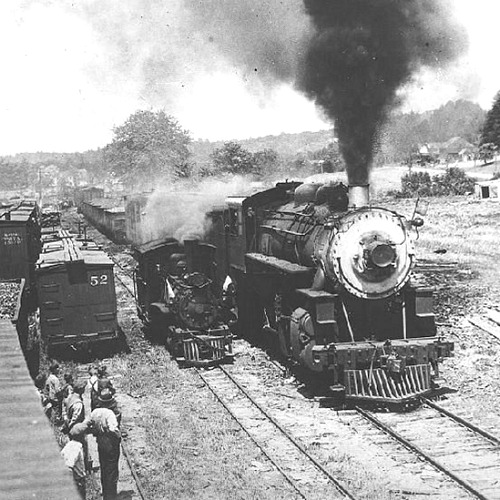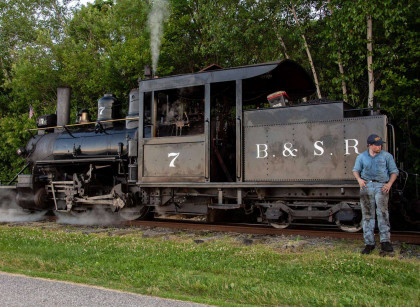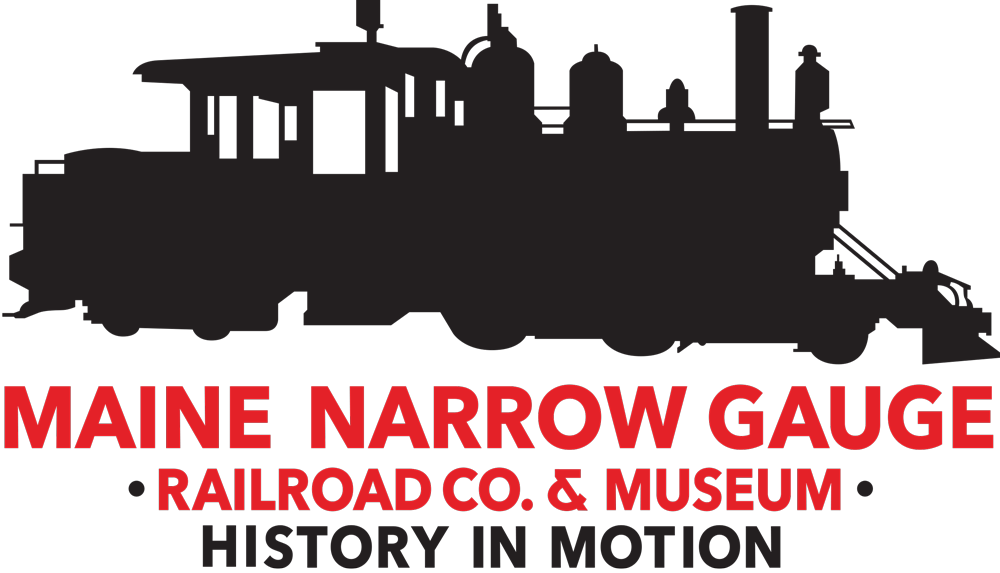
WHAT IS NARROW GAUGE? WHY ARE THE TRAINS SO SMALL?
Starting in the latter part of the 19th century, Maine had an especially unique system of railroads that ran on rails that were only 2 feet apart. Conventional railroads since the mid-19th century operated on / continue to operate on rails that are spaced 4 feet, 8.5 inches apart. This specific figure can be traced back to the traditional width of horse-drawn roadways in England, where railroading was first developed.
Railway engineers soon discovered that it was signifanctly cheaper – and remarkably easier – to build railroads of a “narrower gauge” when faced with hilly or curvy terrain. While “standard gauge” rails placed 4 feet, 8.5 inches apart provided stability and allowed very large trains to run fast, “narrow gauge” rails could be laid more quickly, could let the train go around tighter curves, and could more easily handle rough or mountainous landscapes. Narrow gauge offered an affordable alternative for railroads to more easily access places and businesses that would have been cost-prohibitive for standard gauge rails to reach. Mines, quarries, factories, and isolated towns around the world benefitted from rail service provided by narrow gauge railways. Simply speaking, narrow gauge railroads could go where the standard gauge railroads could not.
While most narrow gauge railroads in the US have rails spaced 3 feet apart, Maine developed an almost entirely unique system in North America of rails spaced even closer together – 2 feet. The advantage was that Maine’s remote towns, separated by rocky hills, thick forests, and undulating topography, could be most efficiently served by 2-foot rails. The 2-foot system was inspired by railways in Wales that had conquered their own challenging terrain with this unique rail system.
To prove the advantage of 2-foot railroading in the US, one particular railroad promoter, George Mansfield, opened a series of these railroads in the late 19th century, first in Massachusetts, and then in Maine. Mr. Mansfield’s estimations were correct: it usually cost 1/3 to 1/2 to construct a 2-foot railroad as it would to construct a standard gauge railroad, and the day-to-day operational savings were just as impressive. It is worth noting that while many visitors regard our 2-foot equipment as a novelty, their small size and unique proportions came about because of operational necessity.
The disadvantage was that while 2-foot railroads were affordable to operate and easy to build, the small width between the rails meant that locomotives, passenger cars, and freight cars had to be scaled down accordingly. This limited their power and speed – but at a time when freight shipments were smaller, and high speed was not a large priority for most customers, this was rarely a big problem.
Between the 1870s until the 1940s, some 200 miles of narrow gauge lines had been laid to serve many of Maine’s smaller communities. Eventually there were five of these railways:
- Sandy River and Rangeley Lakes (1879-1935)
- Bridgton & Saco River / Bridgton & Harrison (1881-1941)
- Monson (1883-1943)
- Kennebec Central (1890-1929)
- Wiscasset, Waterville and Farmington (1894-1933)
Transporting both passengers and freight, they were the smallest narrow gauge common carrier railroads in the United States. They connected the less populated rural areas of Maine with the larger cities and towns, and thus were an important part of the economic development of the interior of Maine – as well as being almost totally unique in terms of rail operations in the country.
Like the majority of railroads at the time, Maine’s 2-foot narrow gauge railroads fell victim to increased competition from automobiles and better public roads in the 1920s and 30s. One by one, the 2-foot railroads closed, scrapped or sold their equipment, and tore up the narrow roadbeds. The last railroad to close was the Monson Railroad (the original home of our steam locomotives #3 and #4), which ironically was the shortest of Maine’s narrow gauge railroads.
Dedicated enthusiasts and entrepreneuers saved as much as they could from the scrapper’s torch. One figure, Ellis D. Atwood, was especially involved in purchasing and preserving Maine’s surviving 2-foot railroad equipment. Mr. Atwood purchased a large assortment of locomotives, passenger cars, freight cars, and additional supplies, which he transferred to his “Edaville Railroad” in Carver, MA in the mid-1940s. Under his direction, Edaville restored and operated the surviving equipment for nearly 50 years, until the operation closed and the equipment was sold off.
The majority of Edaville’s roster found a home with the newly-established Maine Narrow Gauge Railroad & Museum in Portland, where volunteers still lovingly preserve and operate 2-foot steam and diesel trains along a scenic 1.5-mile stretch of 2-feet track along Casco Bay. We are grateful for the passionate legacy of our predecessors whose tireless work has kept this incredibly unique collection of Maine lore alive.

FOUNDING
Founded in 1992, the Maine Narrow Gauge Railroad Co. & Museum is a 501(c)3 nonprofit educational organization with a mission to educate the public and preserve historic equipment related to Maine’s two-foot gauge railways. The museum has become a popular visitor attraction for the greater Portland area surpassing over 55,000 visitors annually, including tourists and area residents, to experience a remarkable piece of history unique to the state of Maine.

